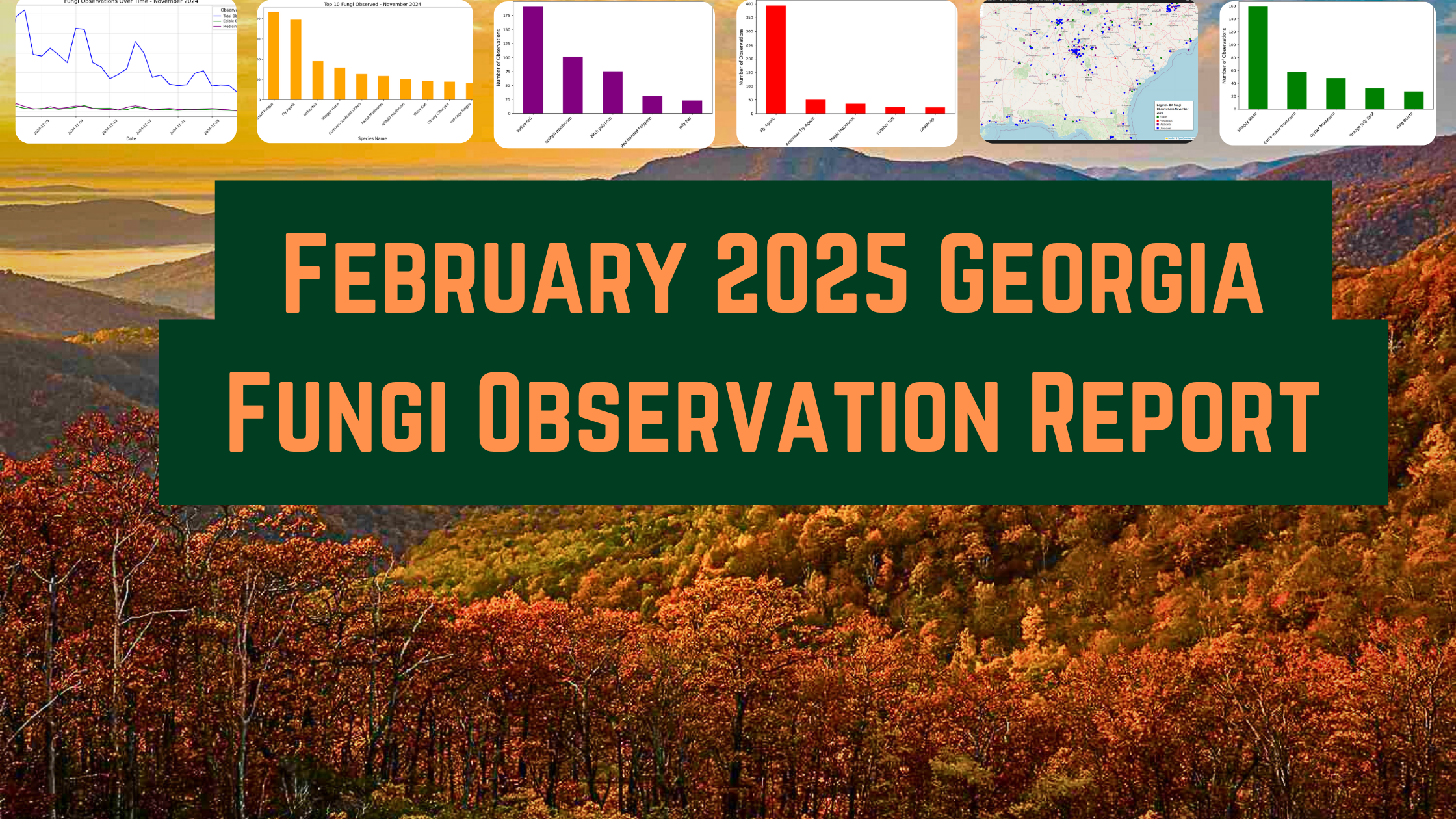Table of Contents
Introduction
As spring approaches, Georgia’s fungal landscape continues to evolve, reflecting seasonal shifts in temperature and moisture. February 2025 recorded a notable number of fungi observations, providing valuable insights into the state’s biodiversity. This report highlights key findings, including total observations, top species, edible and medicinal fungi, and geographical distribution.
Dataset Info:
- Source: INaturalist.com (* A scientific data repository for biological and ecological data*)
- Data Query: (*Retrieved Georgia fungi observations for February 2025*)
Key Summary of Fungi Observations

During February, a total of 1,748 fungi observations were recorded across Georgia, encompassing 448 unique species. Among them, 9 species were classified as edible, while 7 species were identified as medicinal fungi. These numbers reflect a slight decrease in total observations compared to January, likely influenced by winter conditions.
Trends & Insights from February 2025

Observation activity fluctuated throughout the month, with the most significant spike occurring on February 8th, reaching 234 recorded fungi. Additional peaks were noted on February 9th (123 observations) and February 16th (111 observations). These surges in activity may be attributed to optimal weather conditions and increased engagement from foragers and mycologists.
Conversely, lower observation days were recorded towards the end of the month, indicating possible environmental factors such as temperature drops and drier conditions affecting fungal fruiting.
Most Observed Fungi Categories

The diversity of Georgia’s fungi remains vast, with Fungi including lichens being the most commonly observed category, totaling 88 observations. Other frequently recorded species include turkey-tail (74 observations), oyster mushroom (61 observations), and various lichen types. The presence of gilled polypores, crowded parchment, and amber jelly fungi further underscores the broad ecological roles fungi play in forest decomposition and nutrient cycling.
Top Edible Fungi

Edible fungi observations in February were led by oyster mushrooms (61 observations), followed by American amber jelly fungus (30 observations), witch’s butter (11 observations), orange jelly spot (7 observations), and lion’s mane mushroom (5 observations). While numbers are lower compared to January, oyster mushrooms continue to be one of the most sought-after edible species due to their widespread availability and culinary value.
Top Medicinal Fungi

Several medicinal fungi were documented throughout February, with turkey-tail (74 observations) remaining the most prominent. Other notable species included splitgill mushroom (18 observations), golden reishi (7 observations), lion’s mane mushroom (5 observations), and velvet foot (4 observations). These fungi are widely recognized for their potential health benefits, including immune support, anti-inflammatory properties, and cognitive enhancement.
Geographical Distribution
Fungal distribution patterns across Georgia remained consistent with previous months. The Atlanta metro area recorded the highest density of observations, followed by key locations in Augusta, Columbus, and coastal regions like Savannah. Notably, regions with higher moisture levels, such as riverbanks and forested areas, continue to yield the greatest variety of fungal species, emphasizing the impact of climate and habitat diversity on fungal growth.
Conclusion
February 2025 brought a rich variety of fungi observations, despite a slight dip in overall numbers compared to January. The month’s findings reinforce Georgia’s status as a hotspot for mycological activity, attracting both researchers and foragers alike.
As we transition into spring, we anticipate further shifts in fungal diversity, particularly with increasing temperatures and rainfall. Stay connected for next month’s report, and don’t forget to share your fungal discoveries with Hikes of Georgia!

